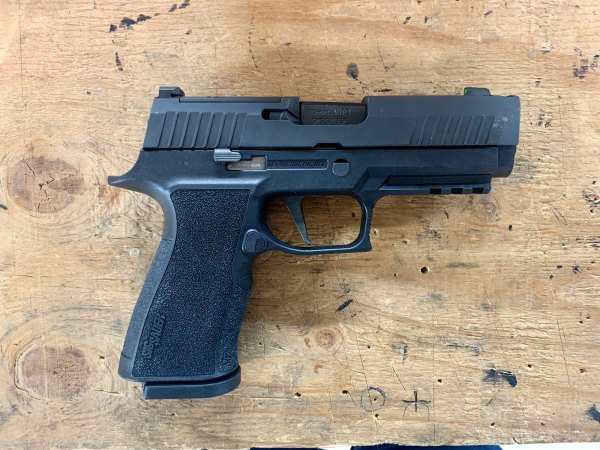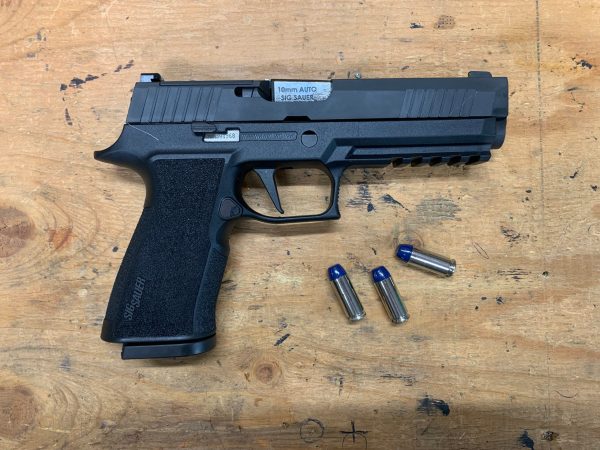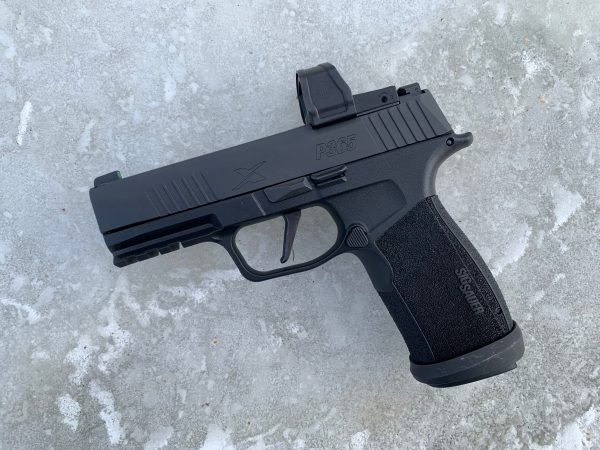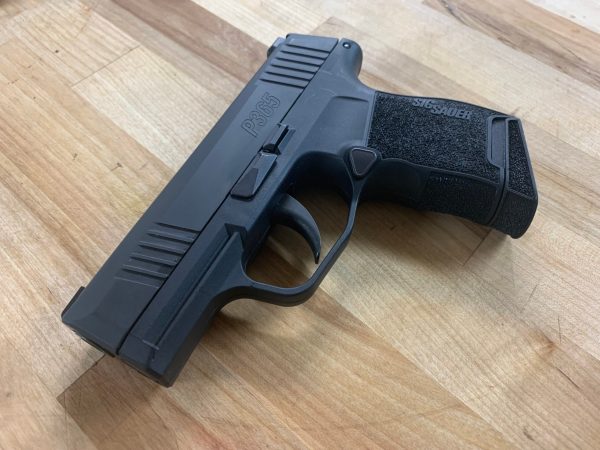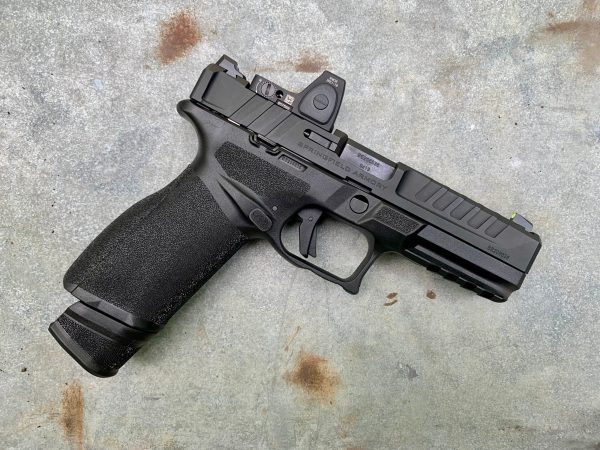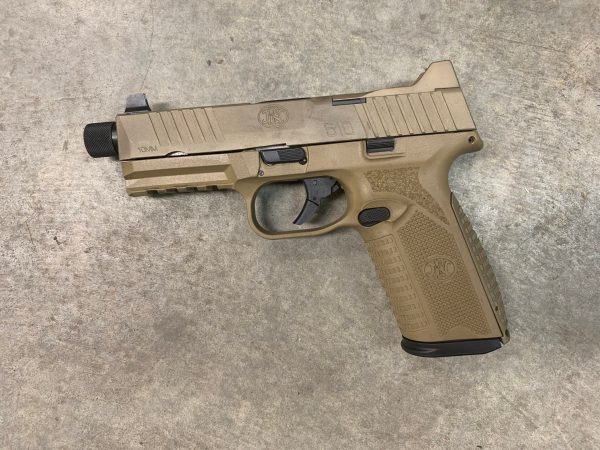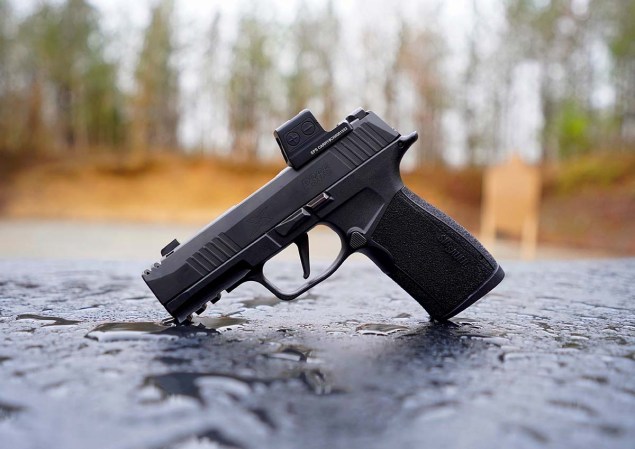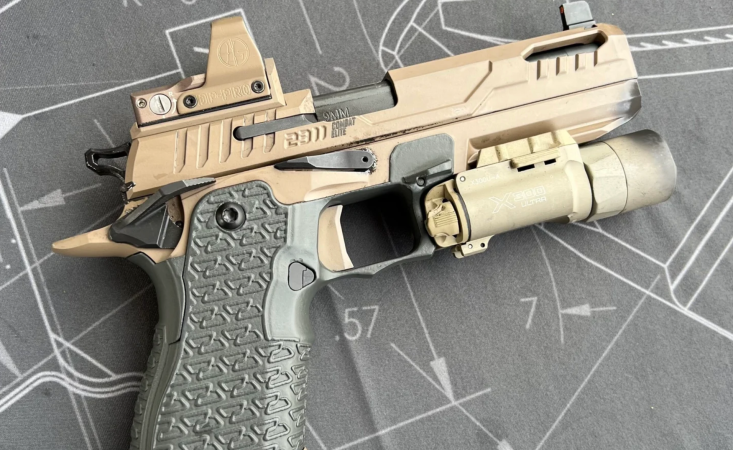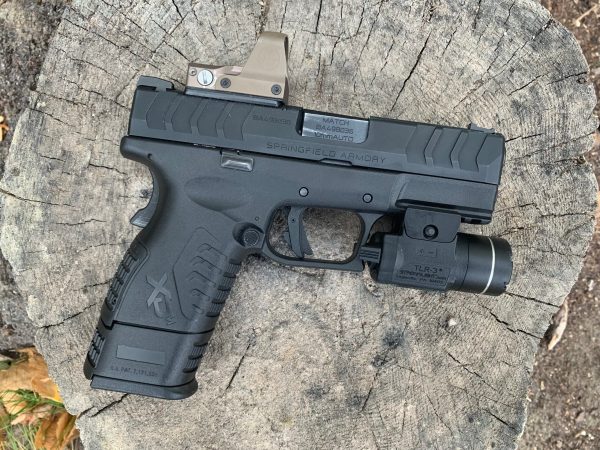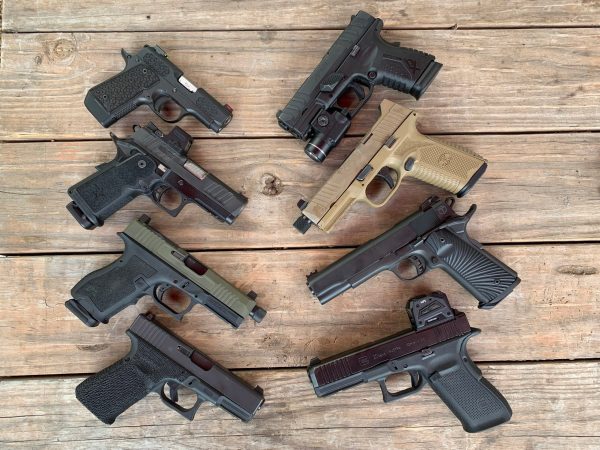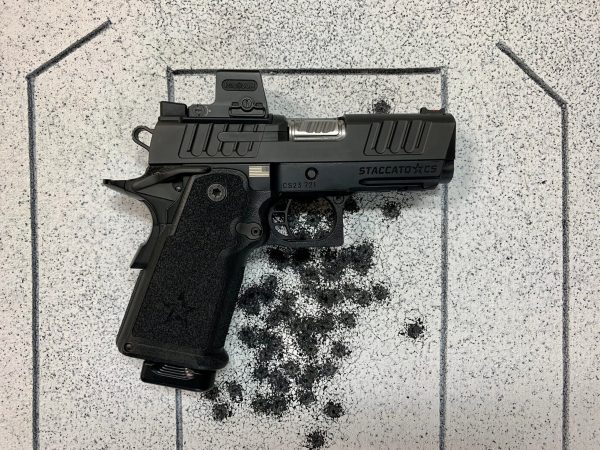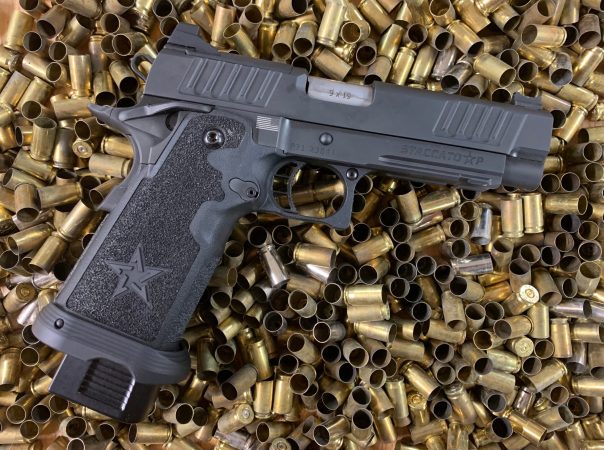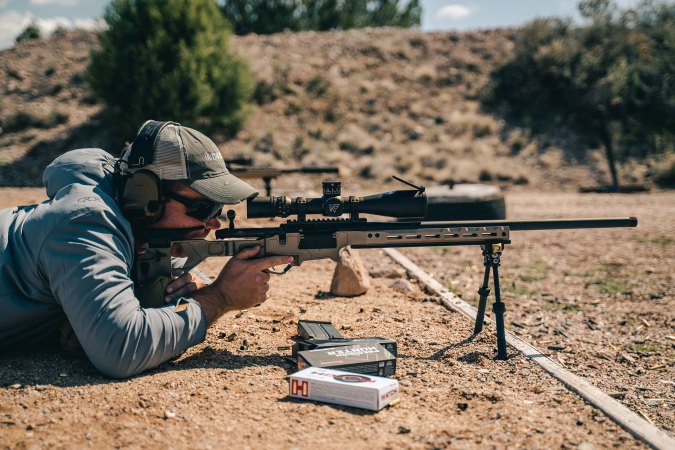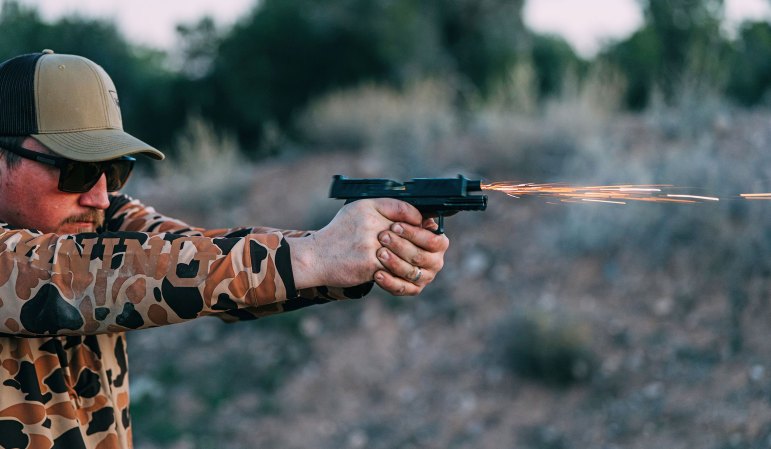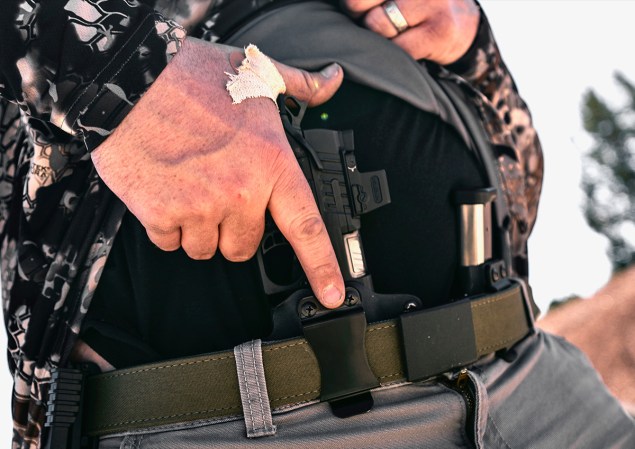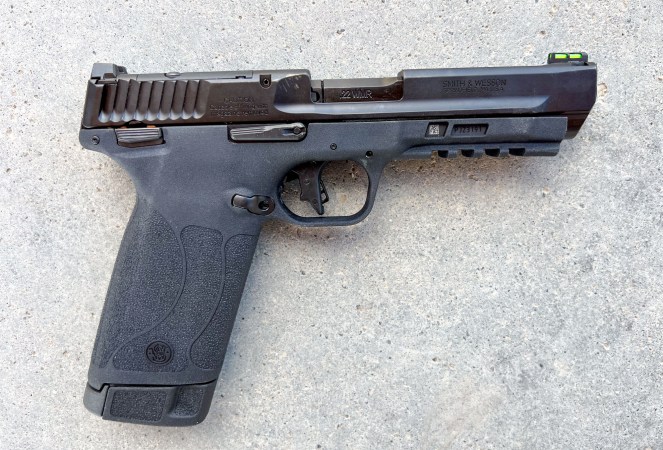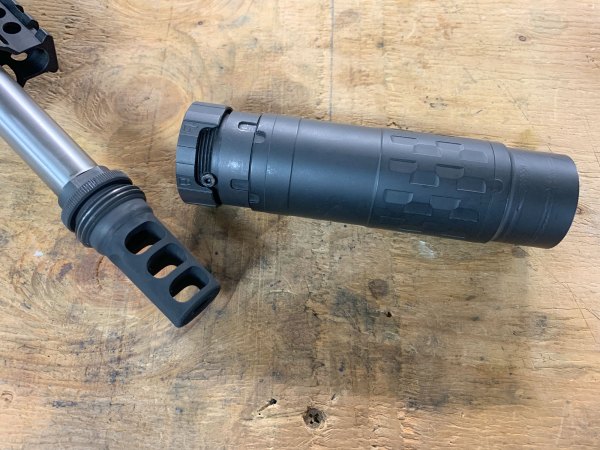We may earn revenue from the products available on this page and participate in affiliate programs. Learn More ›
The new Sig Sauer P320 XTen Comp is a line extension that hasn’t initially turned many heads — and why should it? I count a total of 27 different P320 models on Sig’s website, encompassing a variety of sizes, configurations and colors. This might seem like an overboard move to tempt cosplaying fanboys, but Sig really has done an excellent job of optimizing their modular designs with specific models that target niche applications and market segments. We’ve seen this with the p365, which captured a following in the micro-compact market, and was then modified to create a slightly upsized 18-round-capacity subcompact, the P365 XMacro.
The P320 XTen, a 10mm that uses many standard P320 parts, and has outer grip dimensions that aren’t any bigger than the 9mm version, was a big hit for Sig. The new XTen Comp is everything that’s good about the standard XTen, but layers on some key features that make it even more effective and shooter-friendly. Since its launch in late 2023, it doesn’t seem to be making waves in the market, but I can guarantee that if you shoot the new Sig P320 XTen Comp with other pistols in its peer group, you’ll want one.
Specs
- Caliber: 10mm Auto
- Capacity: 15+1
- Magazine Material: Steel
- Dimensions: 5.75 inches (H) x 7.6 inches (L) x 1.4 inches (W)
- Weight: 32 ounces (weighed with empty magazine, no optic)
- Frame: Polymer
- Slide: Stainless steel, black nitron finish
- Barrel: 3.8-inch, black finish
- Sights: X-ray 3-dot night sights
- Optic ready: Yes, Delta Point Pro footprint
- Trigger: Single-action, flat shoe, 5 pounds 9 ounces (measured)
- Safety: No mechanical safety
- Price: $950
Review Highlights
- Good, quick-pointing ergonomics
- Optic-ready, with Delta Point Pro footprint
- Compensator greatly reduces muzzle flip
- Slide is wider than standard XTen — can’t use GoGun Gas Pedal
- Average Group Size: 1.6 inches (5-shot groups at 15 yards)
The P320 XTen and the 10mm Resurgence
I’ve written at length about the renaissance that the 10mm Auto is currently enjoying, and this time, I don’t think it’s going anywhere. The 10mm cartridge compares quite favorably to the .45 ACP for both EDC and backcountry defense, and its shootability has made it a popular alternative to heavy revolvers in .44 Magnum and larger calibers. As its popularity has grown, gunmakers have been optimizing designs of their 10mm pistols to make them more compact and shooter-friendly. Sig hit a home run with the P320 XTen by fitting the larger 10mm cartridge into a pistol with the same outside dimensions and ergonomics as their 9mm models,. It has the most slender and quick-pointing grip profile of any 10mm pistol that I’ve shot — and I’ve shot almost all of them. You can read my full review on the P320 XTen here, and to avoid redundancy, I’ll focus on what’s different or improved with the new P320 XTen Comp.
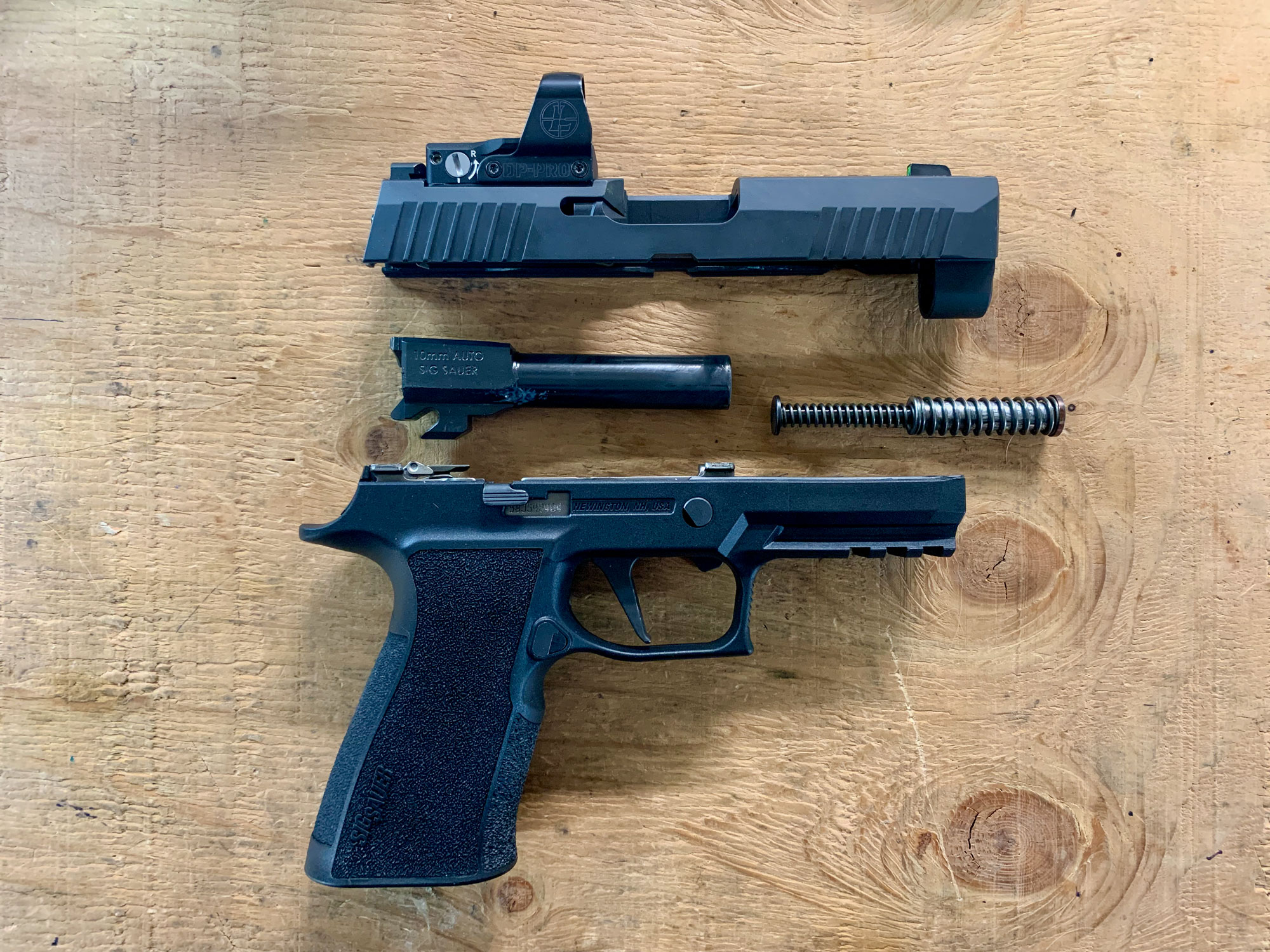
Tyler Freel
The P320 XTen Comp and XTen: What’s The Difference?
The P320 XTen Comp has more in common with the original XTen than not. The Grip module has the same X-series profile, with the same relatively straight grip angle, laser-etched grip texture, and an undercut-style trigger guard. Also like the original XTen, the P320 XTen Comp comes with X-ray 3-dot night sights and an optic cut cover plate. Both models are optic ready with a Delta Point Pro footprint. They use the same 15-round magazines and removable fire control unit (FCU). Both have ambidextrous slide-stop levers and reversible triangular mag catch buttons. They have a few key differences, most of which are improvements.
| P320 XTen | P320 XTen Comp | |
| Barrel Length | 5 inches | 3.8 inches |
| Compensator | No | Yes |
| Slide Width | Flush with grip module | Wider than grip module |
| Overall Length | 8.5 inches | 7.6 inches |
| Accessory Rail | 5-slot | 3-slot |
Putting the “Comp” in Compensator
Any P320 XTen Comp review is obligated to focus on the primary feature of this model, the compensator. Simply adding a compensator isn’t especially innovative or creative, and it’s not likely to get the masses excited—they’ve been duped by under-performing comps before. The promise of a compensator — to have a dramatic impact on muzzle flip and recoil — often falls flaccid. I’ve found that many 9mm compensated models like the P365 XMacro Comp and P365 XL Spectre Comp don’t feel notably different than their non-compensated counterparts. That considered, why does the 10mm with a compensator excite me, and why should you care? It’s all about pressure.
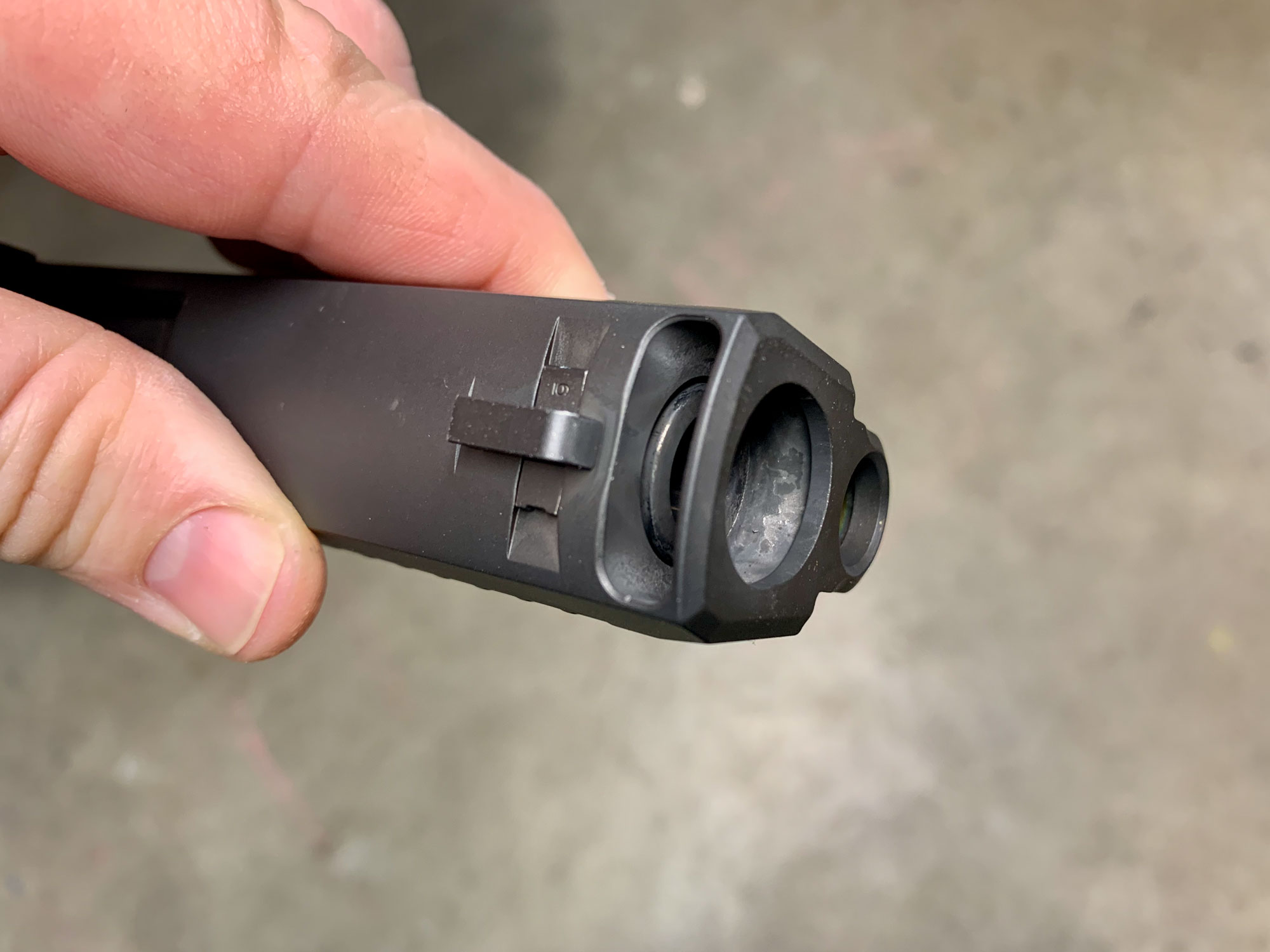
Tyler Freel
What Makes a Compensator Effective?
I attribute the disappointing performance of some comp-equipped 9mm pistols I’ve shot to two things: poor design, and the relatively low pressure and gas volume of the 9mm cartridge. SAAMI pressure limits for 9mm are 35,000 PSI, and most ammo isn’t loaded that hot. Though compensators work better on higher pressure cartridges that fire lighter bullets, like the .38 Super (36,500 PSI), I don’t write them off for 9mm entirely. The design of a compensator certainly matters. I’ve noticed that the less effective “compensator models” often just use a shorter stock barrel with port holes cut into the slide. With normal-pressure rounds, these don’t redirect gasses very effectively. When shooting a P365 XL Spectre Comp, I didn’t notice nearly as much recoil reduction as with another P365 that was fitted with a better-designed aftermarket compensator. That aftermarket compensator worked even better with +P loads.
The Compensator that’s built into the P320 XTen Comp model’s slide isn’t just a hole cut into the top, it’s an actual chamber that’s hogged out just in front of and below the muzzle and shaped to direct the supersonic gasses upwards and out the slide port. It’s very effective at reducing recoil and muzzle flip, making it easier to stay on target and execute quick, accurate follow-up shots. Compared to the original XTen or similar-sized pistols like the Glock G20, FN 510 Tactical, or Smith & Wesson M&P 2.0 10mm, there is no question that the Sig P320 XTen Comp has the softest recoil.
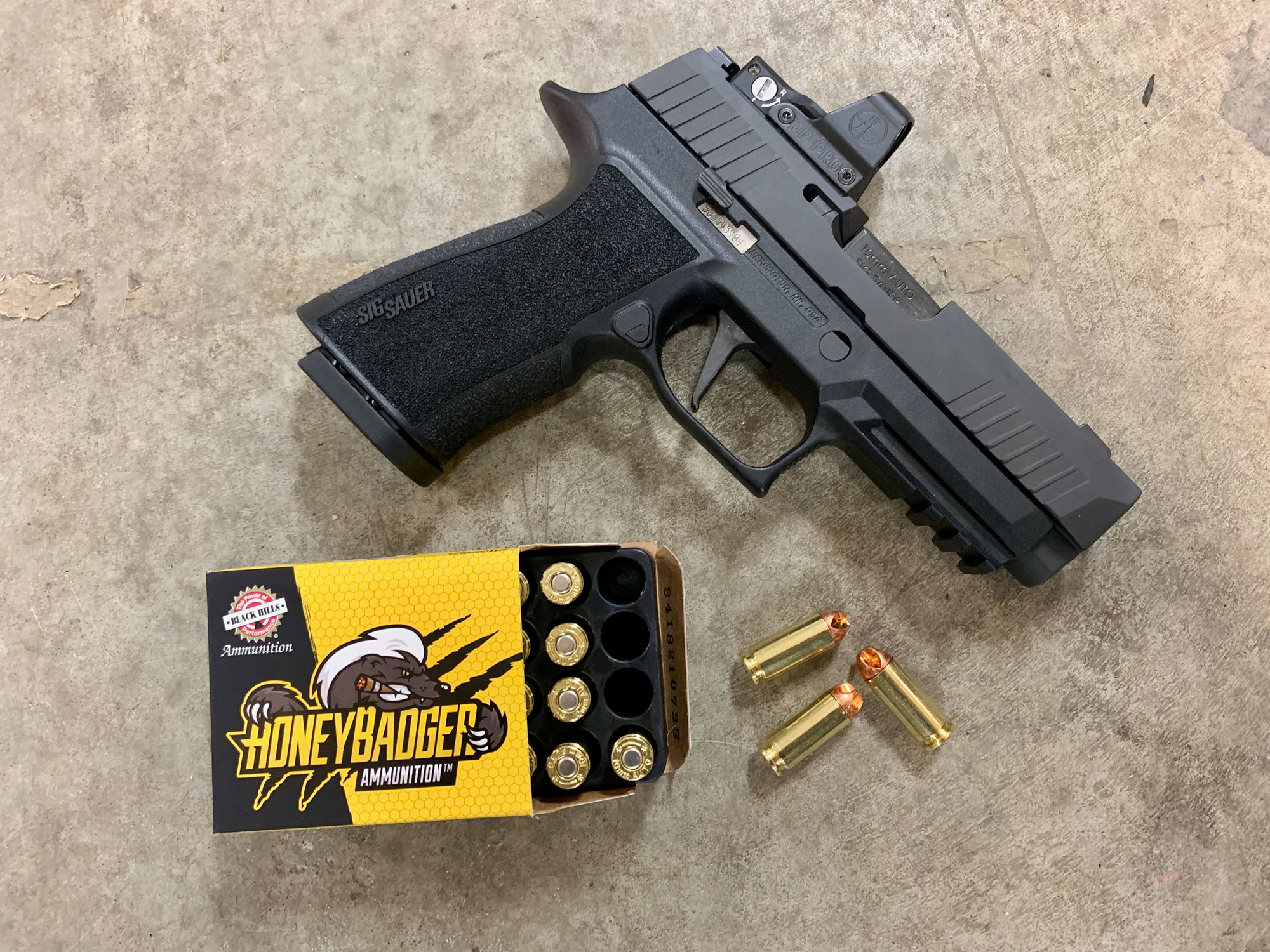
Tyler Freel
Along with good design, the recipe for an effective compensator is high pressure and a light bullet, which is right in the 10mm’s wheelhouse. As with cartridges such as the 9mm, .30 Super Carry, and even .22 LR, bullet technology has been leveraged to increase the terminal performance of the 10mm beyond its former capabilities. There is lots of effective 10mm ammo for various applications, but I’ve come to favor the light 115-grain Lehigh Defense bullet in Black Hills Honeybadger ammo for bear defense. It fires at about 1,575 fps out of a 3.8-inch barrel and creates a wound cavity equal to a 240-grain JHP fired from a 6-inch .44 Mag. This ammo is accurate and it works wonderfully with this pistol’s compensator.
Other Differences
Though the compensator is the biggest difference between the XTen and XTen Comp, there are a couple others worth mentioning.
3.8-inch Barrel
The original P320 XTen has a 5-inch barrel. Because the XTen Comp is an inch shorter overall, and the compensator eats into that barrel space further, its barrel measures only 3.8 inches. Like the longer version, it sports a well-supported chamber, and those with concerns about velocity need not worry. Compared to standard 4.6-inch and 5-inch barrels, 3.8-inch barrels seem to average only about 50 to 75 fps slower. Cutting 1.2 inches off a .44 magnum or .454 Casull barrel will usually result in more dramatic losses because of the slower-burning powder.
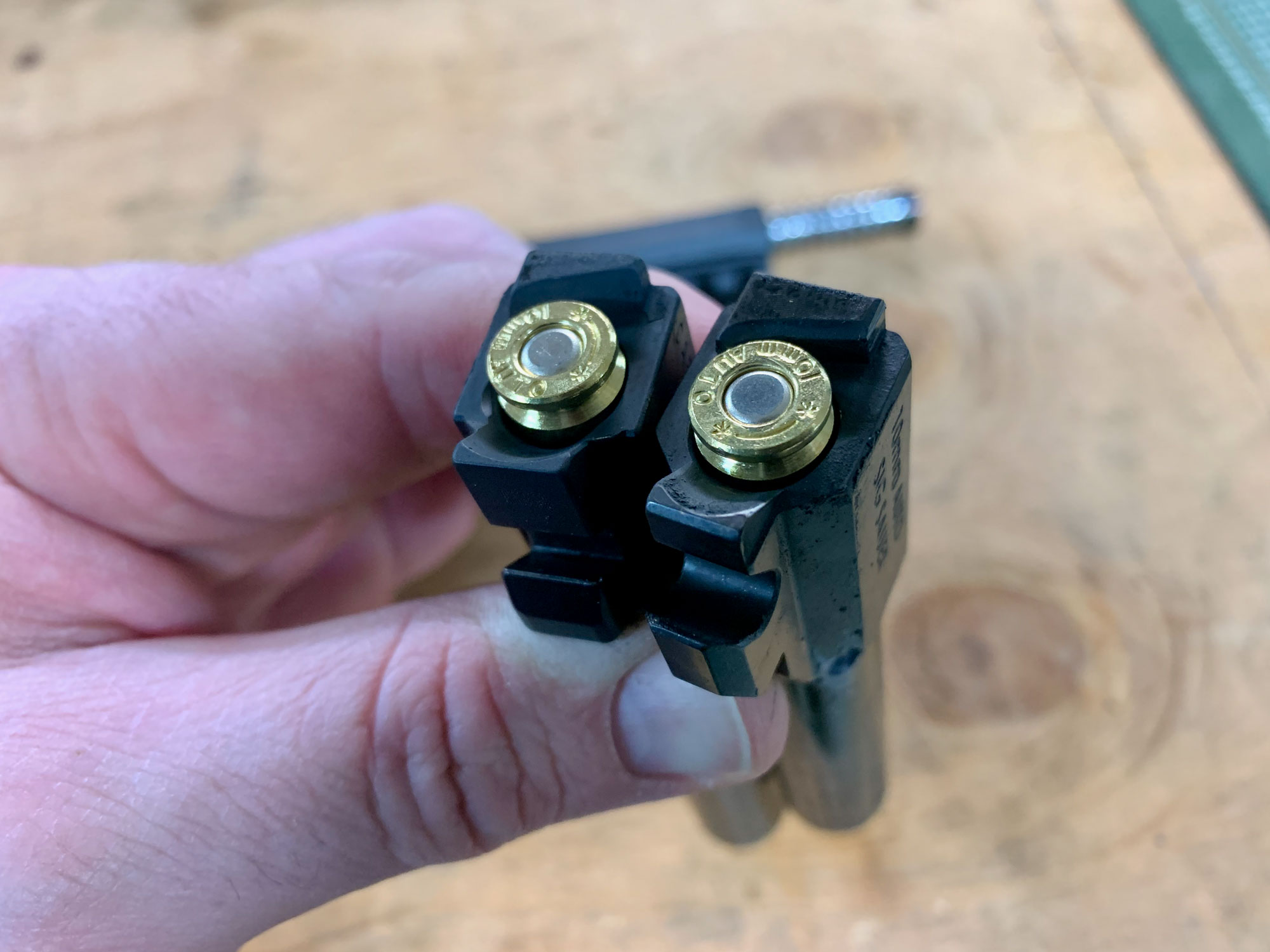
Tyler Freel
Wider Slide
A detail that most shooters wouldn’t even notice, the P320 XTen Comp has a slightly wider slide than the plain XTen model—1.147 vs. 1051 inches. On the original the slide fit flush with the grip module. This won’t mean anything to most shooters, but since the slide now extends over the side edges of the grip module, it prevents the use of a GoGun Gas Pedal takedown lever — an accessory that greatly increased the shootability of the original XTen.
Shooting the P320 XTen Comp
For a well-rounded Sig P320 XTen Comp review, I put 550 rounds through this pistol after equipping it with a Leupold Delta Point Pro reflex sight. I tried every type of 10mm ammo I could get my hands on, ranging from the previously praised 115-grain Honeybadger and 125-grain Fort Scott Munitions TUI monolithics, to various 180-grain ball and JHP defensive loads, to 200- and 220-grain hard cast loads like the Buffalo Bore Heavy Outdoorsman. I ran a variety of drills with the XTen Comp, shooting it with two hands, strong-handed, and weak-handed, and also from a supported position for accuracy data. I shot it alongside my Glock G20, Springfield XD-M 10mm, and FN 510, running Bill Drills with each, which gave me a feel for how quickly I could shoot each pistol while maintaining accuracy. Managing recoil is different for each 10mm, but none of them are as easy to shoot as the XTen Comp. During testing, I cleaned the bore after shooting hard cast bullets and kept the pistol lubricated, but that’s about it. I never encountered any reliability issues.
Accuracy
I was impressed by how accurate the Sig P320 XTen Comp was. Following our handgun accuracy testing protocol, I recorded 5-shot groups at 15 yards from a standing, bagged-tripod-supported position. I recorded 10 groups total with 3 different types of ammo: Black Hills 115-grain Honeybadger, Federal Train + Protect 180-grain JHP, and Winchester USA Ready Defense 180-grain JHP. All groups averaged 1.6 inches, which is pretty damn good, rivaling most production 9mm pistols.
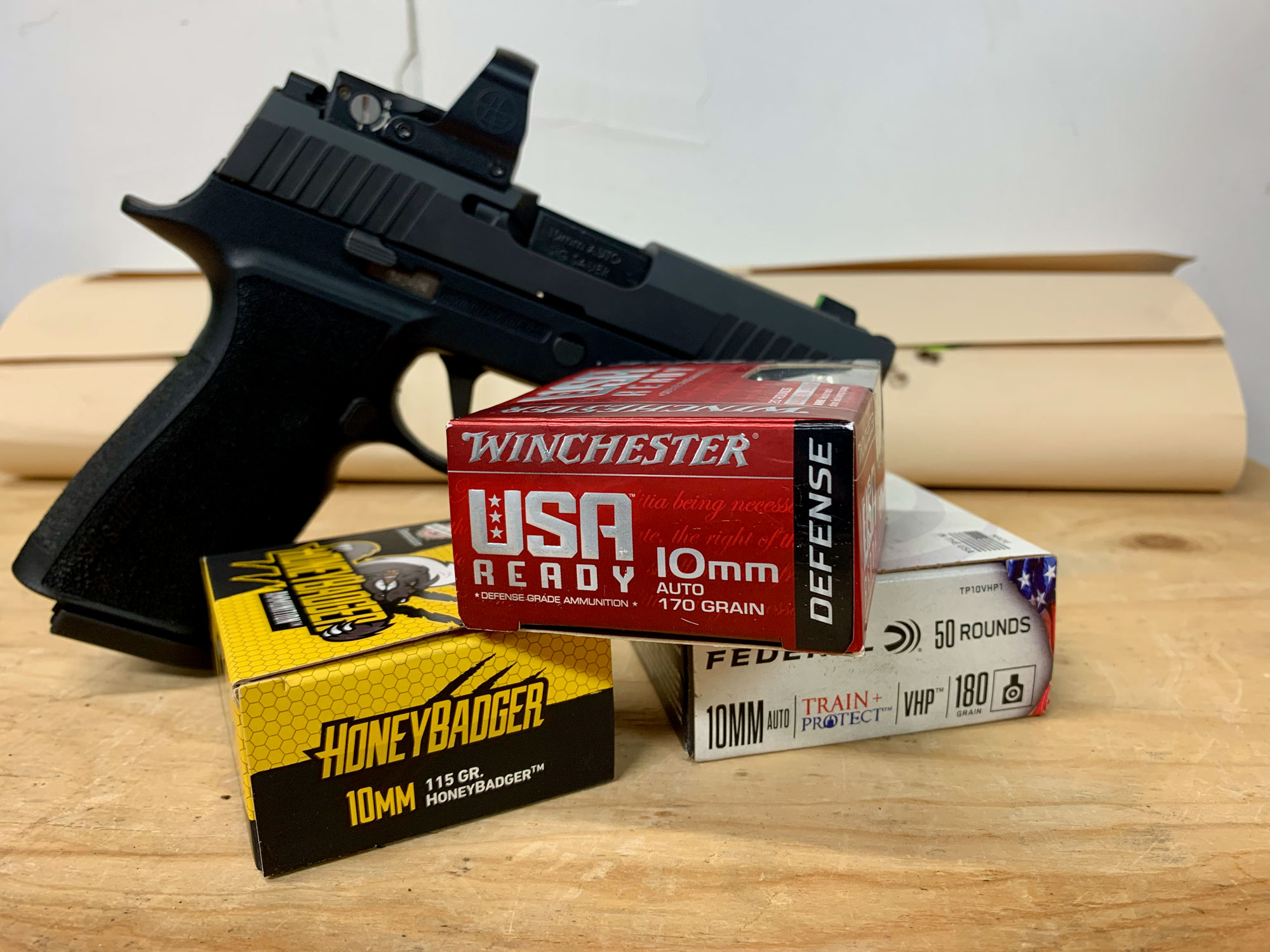
Tyler Freel
Trigger Upgrade
Though I did the bulk of my testing with the stock pistol, and I let out a disappointed sigh when I realized I couldn’t use my Gas Pedal, there is one new aftermarket upgrade that I tested: the enhanced trigger package from KGM Technologies. This small package comes with an improved trigger, sear, and firing pin. Installation is a bit tedious, but it’s easy if you follow any good YouTube P320 FCU teardown tutorials. The KGM trigger didn’t greatly change the feel of the shot, but it reduced the trigger pull weight to 3 pounds, 10 ounces from 5 pounds, 9 ounces and shortened the reset slightly.
A complaint I have about the P320’s trigger is that although it’s not unpleasant, that long trigger pull and overtravel causes me to put a lot of vertical movement into the gun while trying to shoot rapidly, and I often drop follow-up shots low, even with my 9mm models. This enhanced trigger, which breaks lighter and has a shorter reset, helped improve that. It’s an easy upgrade alternative to a whole enhanced FCU that can run you $500 or more.
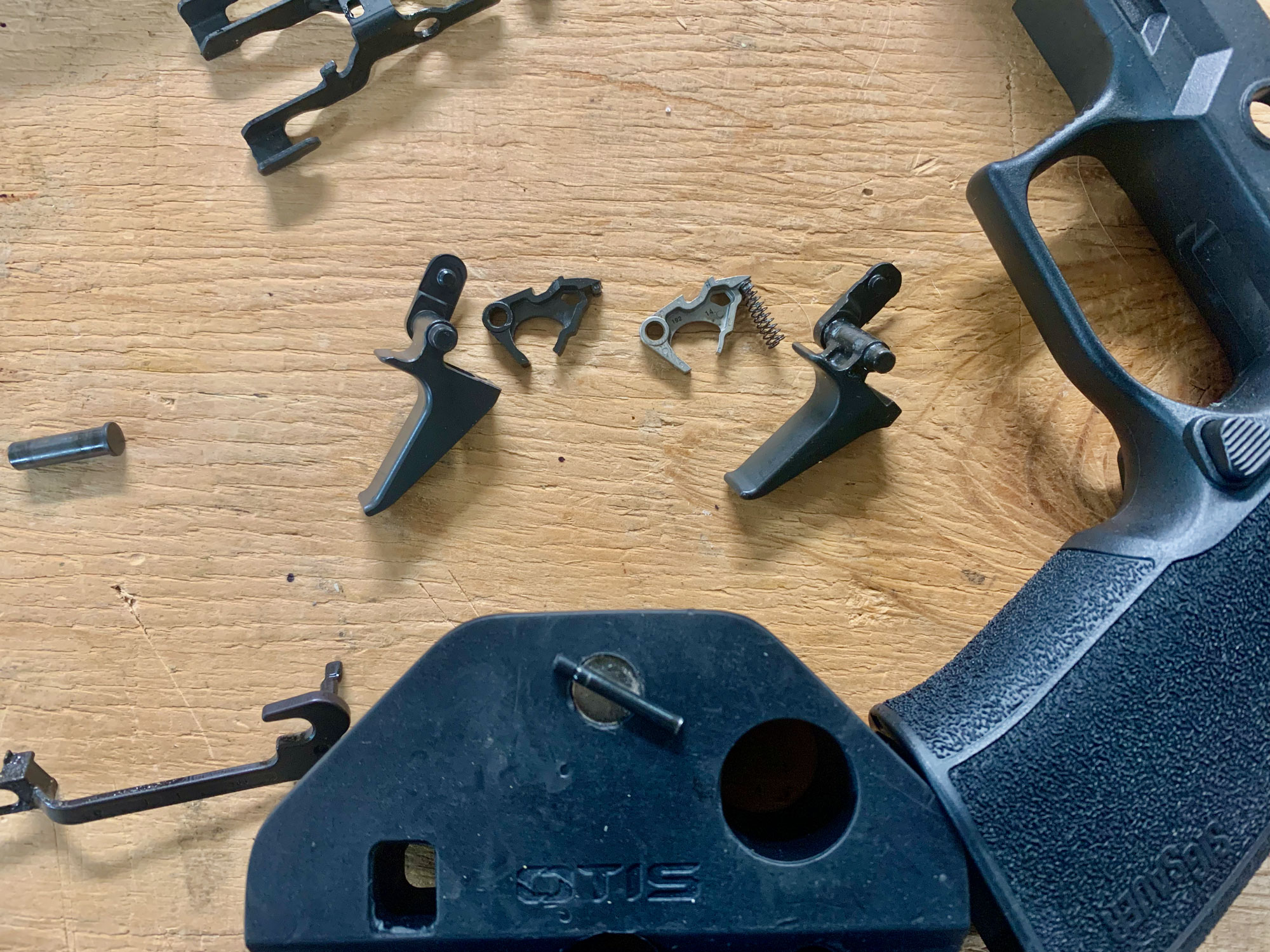
Tyler Freel
Where the Sig P320 XTen Comp Excels
The Sig P320 XTen Comp keeps everything that’s good about the original XTen and makes it more compact and easier to shoot quickly and accurately.
Read Next: How to Hold a Pistol
What the Sig P320 XTen Comp Could Do Better
My main dig on the P320 XTen comp is the slightly wider slide that prevents using the Gas Pedal takedown lever. I think on this 10mm, it would be worth having. That being said, that’s a pretty small gripe. I wouldn’t call the stock trigger bad. However, it can certainly be improved, and is with a KGM enhanced trigger kit.
FAQ
No 10mm pistol truly has complete chamber contact with the case head. However, we would consider the Sig XTen to have a fully-supported chamber—certainly one of the better-supported chambers on the market.
Not if you are a charging bear. Seriously though, yes. The P320 had some drop test issues very early on, but those have been resolved. We have not seen any substantiated reports of current P320s ever firing without the trigger being pulled by someone or something.
Yes, non-jacketed ammunition is safe to fire in your Xten. Just be sure to clean out your bore and remove lead fouling before switching back to jacketed bullets. This is a good practice anyway.
Final Thoughts on the Sig P320 XTen Comp
I think that this pistol is a bit of a sleeper right now. Sig’s frequent line extension launches have been good for them and good for the customer, but I think it’s easy for a pistol like the P320 XTen Comp, which has a few very effective modifications, to slip through the cracks. Shootability and carry friendliness are paramount when it comes to defensive pistols of any type. Sig has made the XTen Comp a 10mm that’s both convenient to carry and easier to shoot than just about any of its competitors. I think it’s unquestionably one of the best 10mm pistols on the market right now.


